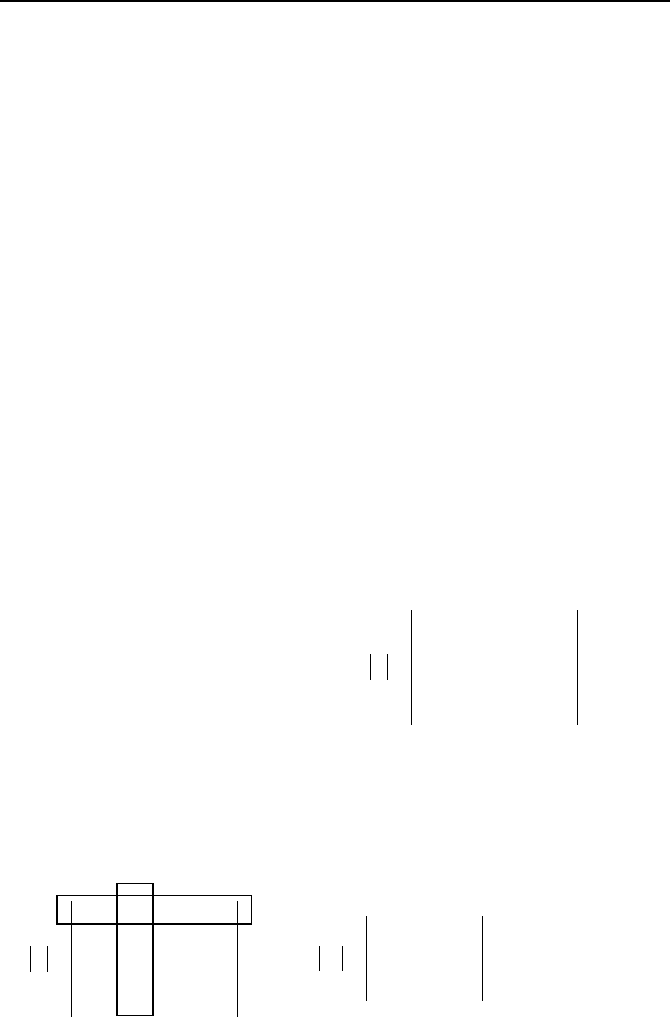Massoud M. Engineering Thermofluids: Thermodynamics, Fluid Mechanics, and Heat Transfer
Подождите немного. Документ загружается.


1. Definition of Terms 963
VIId. Linear Algebra
1. Definition of Terms
Row vector. A row vector is a group of real numbers written in a row. For ex-
ample, the row vector A is defined as
[]
n
aaaaA ,,,,
321
"= . Each individual
number in this vector is referred to as a component.
Column vector. A column vector is a group of real numbers written in a col-
umn. If the column vector has n numbers, then the column vector is an n-
dimensional vector or a vector of order n.
Equal vectors. Two row vectors or two column vectors are equal if they are of
the same order and have identical components.
Addition of vectors. Only vectors of the same type (row or column) and the
same order can be added. For example, the addition of two row vectors of order n
is given as:
[][][ ]
nnnn
bababababbbbaaaaBA ++++=+=+ ,,,,,,,,,,,,
332211321321
"""
Commutative laws of addition. For any n-dimensional row (or column) vec-
tors such as vectors A and B:
A + B = B + A
Associative laws of addition. If A, B, and C are any n-dimensional row (or
column) vectors:
(A + B) + C = A + (B + C)
Multiplication of a vector by a number. If A is an n-dimensional row vector,
then the product of A by a real number c is given as:
[]
n
cacacacacA ,,,,
321
"= .
Multiplication of vectors. If A is a row vector and B a column vector, then the
product of
B
A ⋅ is a scalar given by:
[]
()
»
»
¼
º
«
«
¬
ª
=++++=
»
»
»
»
»
»
¼
º
«
«
«
«
«
«
¬
ª
=⋅
¦
=
n
k
kknn
n
n
bababababa
b
b
b
b
aaaaBA
1
1111311321121111
1
31
21
11
1131211
,,,, "
#
"
Now consider multiplication of a column vector and a row vector:

964 VIId. Engineering Mathematics: Linear Algebra
[]
»
»
»
»
»
»
¼
º
«
«
«
«
«
«
¬
ª
=
»
»
»
»
»
»
¼
º
«
«
«
«
«
«
¬
ª
=⋅
11113112111
11311331123111
211211321122111
111111311121111
1131211
1
31
21
11
,,,,
nnnnn
nn
n
n
n
n
babababa
babababa
babababa
babababa
aaaa
b
b
b
b
BA
"
#####
"
"
"
"
#
The result is called a matrix as defined below.
The distributive law of vectors. If A is a row vector of dimension n and B and
C are column vectors of dimension n, the distributive law specifies that:
CABACBA ⋅+⋅=+⋅ )(
Matrix. A rectangular array of real numbers is called a matrix when arranged
as shown in Figure VIId.1.1(a). Note that in general, the number of rows and col-
umns are different.
¸
¸
¸
¸
¸
¹
·
¨
¨
¨
¨
¨
©
§
=
mnmm
n
n
aaa
aaa
aaa
A
"
####
"
"
21
22221
11211
¸
¸
¸
¸
¸
¹
·
¨
¨
¨
¨
¨
©
§
=
nnnn
n
n
aaa
aaa
aaa
A
"
####
"
"
21
22221
11211
(a) (b)
Figure VIId.1.1. Demonstrations of (a) a matrix and (b) a square matrix
Order of a matrix defines the number of rows and columns. For example, if a
matrix has
m rows and n columns then the matrix is of order m by n or alterna-
tively
m × n. Hence, a row vector is a 1 × m matrix and a column vector is an m
× 1 matrix. Two matrices of the same order are referred to as comforbale.
Square matrix. A
nm × matrix would be referred to as a square matrix if m
= n as shown in Figure VIIc.1.1(b).
Main diagonal. In a square matrix, the main diagonal consists of the a
ii
ele-
ments.
Zero matrix. All the elements of a zero matrix are zeros.
Upper triangular matrix. A square matrix with elements a
ij
= 0 for i > j is
called an upper triangular matrix (Figure VIId.1.2(a)).
Lower triangular matrix. A square matrix with elements a
ij
= 0 for i < j is
called a lower triangular matrix (Figure VIId.1.2(b)).

1. Definition of Terms 965
¸
¸
¸
¸
¸
¹
·
¨
¨
¨
¨
¨
©
§
=
nn
n
n
a
aa
aaa
A
"
####
"
"
00
0
222
11211
¸
¸
¸
¸
¸
¹
·
¨
¨
¨
¨
¨
©
§
=
nnnn
aaa
aa
a
A
"
####
"
"
21
2221
11
0
00
¸
¸
¸
¸
¸
¹
·
¨
¨
¨
¨
¨
©
§
=
nn
a
a
a
A
"
####
"
"
00
00
00
22
11
(a) (b) (c)
Figure VIId.1.2. Demonstration of (a) upper triangular, (b) lower triangular, and (c) di-
agonal matrix
Diagonal matrix. All elements of a diagonal matrix are zeroes except for the
elements of the main diagonal. In other words, a matrix which is both upper and
lower triangular, is called a diagonal matrix:
Scalar matrix. A scalar matrix is a diagonal matrix with elements such that
kaaa
nn
==== "
2211
.
Identity matrix. An identity matrix is a scalar matrix with k = 1.
Sums of matrices. If matrix
[
]
mn
ij
aA = is added to (or deducted from) matrix
[
]
mn
ij
bB = , the result would be matrix C with elements given as
[
]
mn
ijij
baC ±= . The commutative and associative laws of addition described for
vectors also apply to matrices. Only matrices of the same order can be summed.
Multiplication of matrices. The product of matrix
[
]
mn
ij
aA = by matrix
[
]
np
ij
bB = is matrix
[
]
mp
ij
cC = with elements given as:
¸
¸
¸
¸
¸
¸
¹
·
¨
¨
¨
¨
¨
¨
©
§
mnmm
inii
n
aaa
aaa
aaa
"
#"##
"
#"##
"
21
21
11211
¸
¸
¸
¸
¸
¹
·
¨
¨
¨
¨
¨
©
§
npnjn
pj
pj
bbb
bbb
bbb
""
#"#"#
""
""
1
2221
1111
=
¸
¸
¸
¸
¸
¸
¸
¹
·
¨
¨
¨
¨
¨
¨
¨
©
§
mpmjm
ip
j
ii
pj
ccc
ccc
ccc
#"
###
""
###
""
1
1
1111
Where element c
ij
of matrix C is given by:
njinjijiji
bababac +++= "
2211,
As shown above, in multiplication of two matrices A and B, these need not be
square matrices. However, the number of columns of matrix A must be equal to
the number of rows of matrix B. It is also important to note that matrix multiplica-
tion is not a linear operation hence,
.BAAB ≠ An example of multiplication of
two square matrices is as follows
¸
¸
¸
¹
·
¨
¨
¨
©
§
−
−
=
¸
¸
¸
¹
·
¨
¨
¨
©
§
−
−−
−
¸
¸
¸
¹
·
¨
¨
¨
©
§
−
−
−
114916
31566
151020
816
531
6117
315
493
211

966 VIId. Engineering Mathematics: Linear Algebra
An example of the multiplication of two non-square matrices, A(n
a
, m)B(m, m
b
) =
C(n
a
, m
b
), is:
»
»
»
¼
º
«
«
«
¬
ª
−
=
»
»
»
»
»
»
¼
º
«
«
«
«
«
«
¬
ª
−
−
−
»
»
»
¼
º
«
«
«
¬
ª
−−
−
−
3755
16342
11574
129
63
72
40
51
49126
75370
1011851
Transpose of a matrix. The transpose of matrix A is matrix A
T
, obtained by
interchanging the rows and columns of A:
¸
¸
¸
¸
¸
¹
·
¨
¨
¨
¨
¨
©
§
=
mnmm
n
n
aaa
aaa
aaa
A
"
####
"
"
21
22221
11211
,
¸
¸
¸
¸
¸
¹
·
¨
¨
¨
¨
¨
©
§
=
mnnn
m
m
T
aaa
aaa
aaa
A
"
####
"
"
21
22212
12111
Note that (A
T
)
T
= A, (A + B)
T
= A
T
+ B
T
, (AB)
T
= B
T
A
T
. Furthermore, matrix A is
said to be symmetric if A = A
T
and is said to be skew symmetric if A = – A
T
.
Determinant of a square matrix. A determinant of a square matrix is a func-
tional value assigned to the numbers in the square array. While a matrix is repre-
sented by an array of numbers within brackets, the determinant of the matrix is
represented by the same array of numbers within two parallel lines:
¸
¸
¸
¸
¸
¹
·
¨
¨
¨
¨
¨
©
§
=
nnnn
n
n
aaa
aaa
aaa
A
"
####
"
"
21
22221
11211
nnnn
n
n
aaa
aaa
aaa
A
"
####
"
"
21
22221
11211
=
Minor determinant of a square matrix. If we eliminate the row and column
associated with element a
ij
of matrix A then the remaining array of numbers make
up the elements of a minor determinant shown by M
ij
. Therefore, there are as
many minor determinants as the number of elements in the matrix. Note that if the
order of matrix A is n, the order of each minor determinant is n – 1. . For exam-
ple, for element a
12
, of matrix A, the minor determinant is found as:
nnnn
n
n
aaa
aaa
aaa
A
"
####
"
"
21
22221
11211
= ,
nnn
n
aa
aa
M
"
###
"
1
221
=
Example: Let’s find the minor determinant corresponding to elements a
22
, a
23
,
and a
32
of matrix A below:

1. Definition of Terms 967
¸
¸
¸
¹
·
¨
¨
¨
©
§
−
−
−
=
843
315
261
A ,
83
21
22
−
=M
,
43
61
23
−
−
=M
,
35
21
32
−
−
=M
,
Cofactor of an element of a matrix. The minor determinant multiplied by
(–1)
i+j
is called the cofactor of element a
ij
of matrix A and is designated as
c
a
ij
A .
For example, the cofactors of a
11
, a
23
, and a
33
of matrix A below are obtained as:
¸
¸
¸
¹
·
¨
¨
¨
©
§
−
−
−−
=
279
450
312
A
,
27
45
)1(
2
11
−
−
−=
C
A
,
79
12
)1(
5
23
−
−−
−=
C
A
,
50
12
)1(
6
33
−−
−=
C
A
The cofactor matrix. A matrix whose elements are the cofactors of the ele-
ments of matrix A is known as the cofactor matrix of A. A matrix and its associ-
ated cofactor matrix are written as:
¸
¸
¸
¸
¸
¹
·
¨
¨
¨
¨
¨
©
§
=
nnnn
n
n
aaa
aaa
aaa
A
"
####
"
"
21
22221
11211
,
¸
¸
¸
¸
¸
¹
·
¨
¨
¨
¨
¨
©
§
=
c
nn
c
n
c
n
c
n
cc
c
n
cc
c
AAA
AAA
AAA
A
"
####
"
"
21
22221
11211
Example: Consider matrix A and its associated cofactor matrix (A
c
):
¸
¸
¸
¹
·
¨
¨
¨
©
§
−
−
−−
=
679
851
325
A
¸
¸
¸
¹
·
¨
¨
¨
©
§
−−
−−
−−−
=
23371
53579
527826
c
A
Determinant of a square matrix. For matrix A of order n, the value of the de-
terminant is given as:
¦¦
=−=
+ c
a
ijijij
ji
ij
AaMaA )1( VIId.1.1
where
ij
jic
a
MA
ij
+
−= )1( is the cofactor and M
ij
is the minor determinant associ-
ated with element a
ij
. This minor determinant is of order n – 1 and obtained by
deleting the ith row and jth column, as discussed before. For a matrix of order n,
there are n! terms to evaluate. Consider first a matrix of order 2. There are 2! = 2
terms to evaluate. Using Equation VIId.1.1, the determination of a matrix of or-
der 2 becomes:
21122211
2221
1211
aaaa
aa
aa
A −==

968 VIId. Engineering Mathematics: Linear Algebra
We now calculate the determinant of a matrix of order 3. In this case, there are 3!
= 6 terms to evaluate:
)()()(
221323123132133312212332332211
2322
1312
31
3332
1312
21
3332
2322
11
333231
232221
131211
aaaaaaaaaaaaaaa
aa
aa
a
aa
aa
a
aa
aa
a
aaa
aaa
aaa
A
−+−−−
=+−==
Example: The determinant of matrices A, B, and C are calculated as follows:
721
1310
561
942
−=
−−
−
−
=A
,
4
774340
512827
271514
=
−
−−
−
=B
,
1000
305045
403015
252010
=
−
−−
−
=C
Singular matrix. If the determinant of a matrix is zero, then the matrix is sin-
gular.
Adjoint matrix. The transpose of the cofactor matrix is called the adjoint ma-
trix. Matrix A, the cofactor matrix A
c
, and the adjoint matrix of A are shown in
Figure VIId.1.3(a), (b), and (c), respectively.
¸
¸
¸
¸
¸
¹
·
¨
¨
¨
¨
¨
©
§
=
nnnn
n
n
aaa
aaa
aaa
A
"
####
"
"
21
22221
11211
,
¸
¸
¸
¸
¸
¹
·
¨
¨
¨
¨
¨
©
§
=
nnnn
n
n
AAA
AAA
AAA
C
"
####
"
"
21
22221
11211
,
¸
¸
¸
¸
¸
¹
·
¨
¨
¨
¨
¨
©
§
=
nnnn
n
n
AAA
AAA
AAA
adjA
"
####
"
"
21
22212
12111
(a) (b) (c)
Figure VIId.1.3. Demonstration of (a) square matrix, (b) the cofactor matrix, and (c) the
adjoint matrix.
Diagonally dominant matrix. In diagonally dominant matrices, the magnitude
of the element located on the diagonal in each row is larger than the sum of the
magnitude of all the other elements in that row:
¦
≠
>
ijall
ijii
aa
2. The Inverse of a Matrix
The inversion of a matrix is very important in determining solutions to sets of al-
gebraic equations. The process of matrix inversion is analogous to division for
real numbers. If matrix B is the inverse of matrix A, then the product of matrices
A and B is equal to the identity matrix, AB = I. The inverse of a matrix is denoted

2. The Inverse of a Matrix 969
¸
¸
¸
¹
·
¨
¨
¨
©
§
−−
−
−
=
4111
792
1105
A
,
¸
¸
¸
¹
·
¨
¨
¨
©
§
−−−
−−−
=
253779
115941
1018529
c
A
, C =
()
¸
¸
¸
¹
·
¨
¨
¨
©
§
−−
−−
−−
==
25115101
37985
794129
adjAA
T
c
(a) (b) (c)
Figure VIId.2.1. Demonstration of (a) a square matrix, (b) the cofactor matrix, and (c)
the adjoint matrix
as B = A
– 1
. But not every matrix has an inverse. There are two conditions for a
matrix to have an inverse. The first condition requires the matrix to be square so
that a determinant can be calculated. The second condition requires the determi-
nant of the matrix to be nonzero otherwise the matrix is singular. To inverse ma-
trix A, we first replace all elements by their associated cofactors to obtain the co-
factor matrix, A
c
. We then transpose the cofactor matrix to obtain the adjoint
matrix. The inverse of the matrix is the result of the division of the elements of
the adjoint matrix by the determinant of matrix A:
A
adjA
A =
−1
For example, if we want to find the inverse of matrix A, Figure VIId.2.1(a), we
must first find the cofactor matrix by replacing each element of matrix A by its
minor determinant, using the correct sign. This is shown in Figure VIId.2.1(b).
The adjoint matrix of A is then obtained by transposing matrix A
c
. Finally, the in-
verse matrix A
–1
is obtained by dividing elements of matrix C by the determinant
of matrix A.
Elements of the cofactor matrix are obtained as follows. For element a
11
= –5,
we substitute from the minor determinant obtained from eliminating elements in
the first row and the first column of matrix A to get [
)71(49 ×−−×− ] = – 29. We
retain the sign as the summation of first row and first column is an even number.
Similarly, for element a
21
= 2 we substitute from )]1(1410[ −×−× = 41. How-
ever, the sign for this term would be minus since the summation of the row and
column is an odd number.
We now calculate the determinant of matrix A. This is facilitated as we already
have the minor matrices:
806)79(11)41(2)29(5
4111
792
1105
−=−−−−=
−−
−
−
=A
Having the adjoint matrix, Figure VIId.2.1(c) and the determinant, the inverse ma-
trix becomes:

970 VIId. Engineering Mathematics: Linear Algebra
¸
¸
¸
¹
·
¨
¨
¨
©
§
−
−
−
=
−
0310.01430.0125.0
0459.00112.0105.0
0980.00509.0036.0
1
A
To ensure that we have made no algebraic error, we should calculate the product
of AA
-1
= I:
¸
¸
¸
¹
·
¨
¨
¨
©
§
−−
−
−
4111
792
1105
¸
¸
¸
¹
·
¨
¨
¨
©
§
−
−
−
×
0310.01430.0125.0
0459.00112.0105.0
0980.00509.0036.0
=
¸
¸
¸
¹
·
¨
¨
¨
©
§
100
010
001
Several matrices and their inverse matrices are provided below. The reader should
try to follow the above procedure to inverse each matrix and compare the results
with the inverse matrices presented.
Example 1:
¸
¸
¸
¹
·
¨
¨
¨
©
§
−
−−=
1271
409
213
A ,
¸
¸
¸
¹
·
¨
¨
¨
©
§
−
−−−
=
−
06160.01510.04320.0
0411.02330.07120.0
0274.0178.0192.0
1
A , 146=A
Example 2:
¸
¸
¸
¹
·
¨
¨
¨
©
§
−−
−
−−
=
630.075.025.0
4000.056.030.0
079.000.115.0
A
,
¸
¸
¸
¹
·
¨
¨
¨
©
§
−−−
−
−
=
−
46.257.1968.0
953.030.101.1
060.585.7601.0
1
A
, 0878.0−=A
Example 3:
1
10 14 15 8 0.393 0.194 0.113 0.188
13 3 21 13 0.0441 .0089 0.0229 0.072
,
18 12 7 11 1.12 0.431 0.243 0.602
2 19 14 10 1.40 0.581 0.274 0.769
AA
−
−− −
§·§ ·
¨¸¨ ¸
−− −−
¨¸¨ ¸
==
¨¸¨ ¸
−− − − −
¨¸¨ ¸
−− −−−
©¹© ¹
, 6980=A
Example 4:
¸
¸
¸
¸
¸
¹
·
¨
¨
¨
¨
¨
©
§
−
−
−−
−−
=
9023
10108
11932
7654
A
,
¸
¸
¸
¸
¸
¹
·
¨
¨
¨
¨
¨
©
§
−−
−
−−−
−−−
=
−
091.0168.0160.0269.
106.0234.0977.0162.
101.0762.1210.1630.
127.1010.0323.0315.
1
A
, 5550A =−
Such operations can be easily performed by using the accompanying CD-ROM.

3. Set of Linear Equations 971
3. Set of Linear Equations
Mathematical modeling of most physical phenomena reduces to a set of simulta-
neous differential equations the solution of which would determine the parameters
of interest. The solution to such set of equations involves the approximation of
the differential terms by finite difference, for example, and then linearization of
the nonlinear terms. The linearization of a set of non-linear differential equations
is discussed in Chapter VIIe. The net result is a set of linear simultaneous equa-
tions as given in Equation VIId.3.1, which must be solved in each time interval to
obtain the trend of the parameters. There are several techniques for solving a set
of n simultaneous linear equations in n unknowns:
°
°
¯
°
°
®
=++++
=++++
=++++
nnnnnnn
nn
nn
cxaxaxaxa
cxaxaxaxa
cxaxaxaxa
"
#
"
"
332211
22323222121
11313212111
VIId.3.1
such as matrix inversion and the Gauss – Seidel iteration method.
3.1. Solution to a Set of Linear Equations by Matrix Inversion
The above general set of linear equations can be written in the form of a matrix
equation as:
Ax = c VIId.3.2
where A is the coefficient matrix, x is the unknown vector, and c is the constant
vector. If we now multiply both sides of Equation VIId.3.2 by A
–1
we get A
–1
(Ax)
= A
–1
c. Since A
–1
A = I, the left hand-side becomes:
x = A
–1
c
As a result, to solve a set of algebraic equations, we must find the inverse of the
coefficient matrix and multiply it by the vector of the constants. If we place the
vector of constants c as the last column inside the coefficient matrix A, the resul-
tant is called the augmented matrix. Several examples are provided below. The
reader should try to solve these sets and compare the results with those given be-
low.
Example 1. Consider the set of linear equations as shown in Figure VIId.3.1(a).
This set in matrix form is shown in Figure VIId.3.1(b). The augmented matrix of
this set is shown is Figure VIId.3.1(c).

972 VIId. Engineering Mathematics: Linear Algebra
°
°
¯
°
°
®
−=−+−
−=+
=+++−
=−+−
106537
76
1394
5232
4321
41
4321
4321
xxxx
xx
xxxx
xxxx
,
¸
¸
¸
¸
¸
¹
·
¨
¨
¨
¨
¨
©
§
−
−
=
¸
¸
¸
¸
¸
¹
·
¨
¨
¨
¨
¨
©
§
¸
¸
¸
¸
¸
¹
·
¨
¨
¨
¨
¨
©
§
−−
−
−−
10
7
1
5
6537
6001
3941
2132
4
3
2
1
x
x
x
x
,
¸
¸
¸
¸
¸
¹
·
¨
¨
¨
¨
¨
©
§
−−−
−
−
−−
106537
76001
13941
52132
(a) (b) (c)
Figure VIId.3.1. Demonstration of (a) set of linear equations, (b) matrix form, and (c)
augmented matrix
Upon solving the above set, the solution vector becomes x = [– 4.52, –3.91, 1.48, –
0.414]
T
.
Example 2:
°
°
¯
°
°
®
=−−+
−=++−
−=−−+
=+−−
1034137
566
1013344
15212
zyxw
zyxw
zyxw
zyxw
,
¸
¸
¸
¸
¸
¹
·
¨
¨
¨
¨
¨
©
§
−
−
=
¸
¸
¸
¸
¸
¹
·
¨
¨
¨
¨
¨
©
§
¸
¸
¸
¸
¸
¹
·
¨
¨
¨
¨
¨
©
§
−−
−
−−
−−
10
5
10
15
34137
6611
13344
21112
z
y
x
w
,
¸
¸
¸
¸
¸
¹
·
¨
¨
¨
¨
¨
©
§
−−
−−
−−−
−−
1034137
56611
1013344
1521112
The answers obtained for x
1
through x
4
is arranged in the transpose of the solution
vector:
x
T
= [0.0343, 0.405, – 2.18, 1.41]
T
.
3.2. Solution to a Set of Linear Equations by Gauss – Siedel Iteration
This is a simple and effective method to solve sets of linear algebraic equations.
To explain the Gauss – Seidel iteration, let’s consider a set of 3 equations in 3 un-
knowns:
°
¯
°
®
=++
=++
=++
3333232131
2323222121
1313212111
cxaxaxa
cxaxaxa
cxaxaxa
VIId.3.3
This set can be arranged as:
¸
¸
¸
¹
·
¨
¨
¨
©
§
=
¸
¸
¸
¹
·
¨
¨
¨
©
§
¸
¸
¸
¹
·
¨
¨
¨
©
§
3
2
1
3
2
1
333231
232221
131211
c
c
c
x
x
x
aaa
aaa
aaa
We have arranged this set so that the diagonal elements in the coefficient matrix
have the largest magnitude in each row. For example, for row 2 we have a
22
> a
21
and a
22
> a
23
, etc. This arrangement expedites the iteration process. In fact, if the
diagonal elements are larger than the summation of other elements of their corre-
